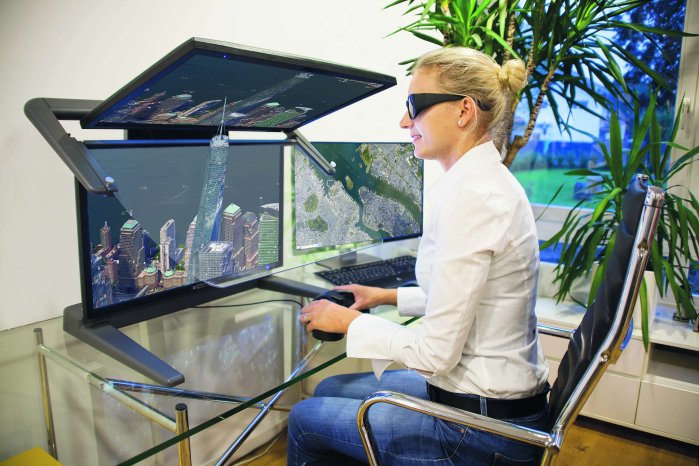Schneider Digital e.K. in Miesbach, a supplier and manufacturer of professional 3D hardware for many years, offers the perfect hardware solution to this challenge by combining work station, 2D/3D monitors and the 3D input device.
Anyone who relies on high-resolution 3D stereo visuals in his profession, e.g. in geoinformatics or molecular research, wants a flicker-free, daylight-readable 3D display which allows him to work for hours in stereo without becoming too tired.
With its 3D PluraView, Schneider Digital has launched a passive 3D stereo display based on beam splitter technology onto the market to meet these needs.
The monitor has been specially developed for the stereoscopic display of 3D software applications in industries such as photogrammetry, scatter plot visualisation of laser scans, and for 3D data visualisation in oil and gas production. There are also many users in computer tomography, medical technology and molecular research.
Schneider Digital, promises that its 3D PluraView will provide extremely comfortable, precise and pixel-perfect image interpretation in very high resolution of 2x 4K with a colour depth of up to 10-bit per RGB.
The manufacturer’s intention is to solve the problems faced by users of devices with shutter technology.
Their active 3D systems require shutter glasses, which cover the left and right eyes alternately to show stereo images. The left and right-hand images are shown synchronously on a monitor. The active 3D glasses only allow the matching image through to the corresponding eye by creating a spatial impression in the brain.
As LCD screens have very strong image persistence where there is sharp contrast and big differences in brightness, the 3D glasses turn both eyes briefly “black” after each screen change. This principle results in a very dark, low-contrast stereo image. The high-frequency shuttering can also strain the eyes and lead to operators becoming tired quickly. Ambient light also amplifies the “flicker effect”.
All 3D PluraViews consist of 2 screens, either equipped with 27” full HD (1920 x 1080 pixels) or as a 28” 4K monitor (3840 x 2160 pixels). This means that a separate display and therefore a separate image in full resolution and high brightness is available to each eye of the user. The image is separated through the centrally-fitted beam splitter mirror flicker-free thanks to passive polarising filter glasses. The monitor is therefore suitable for regular, constant work, even in a 3-shift pattern.
The PluraView uses the BlackTuner technology to help the user see objects more reliably even in dark sections of the image. The LCD panel’s extremely short reaction time of 1 ms helps keep moving images sharp.
The 3D PluraView display supports all standard 3D stereo applications under Linux and Windows.
Summit Evolution from DATEM, DTMaster from Trimble (INPHO), IMAGINE Photogrammetry (LPS) from HEXAGON/erdas, Z/I ImageStation from INTERGRAPH, Gcarto/ArcGDS from Geosoft, SOCET Set/Socet GXP from BAE SYSTEMS, uSMART from SmartTech, TerraSolid, Rhino-Terrain are just some of the certified GIS solutions.
For more information on the 3D PluraView Monitor, visit http://www.3d-pluraview.com/... or send an email to info@schneider-digital.com or call +49 8025 9930-0.


